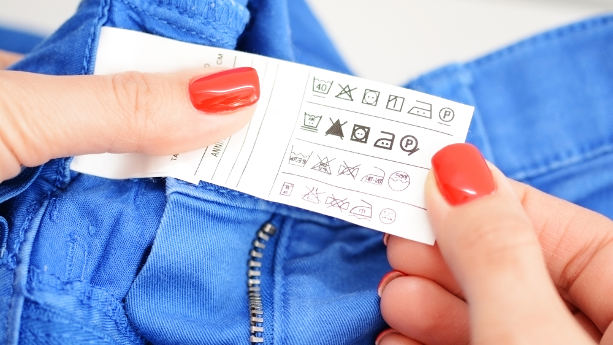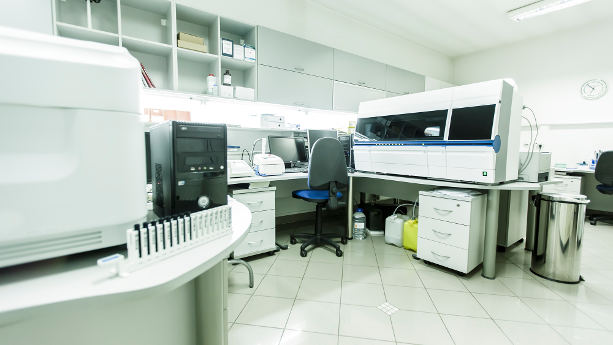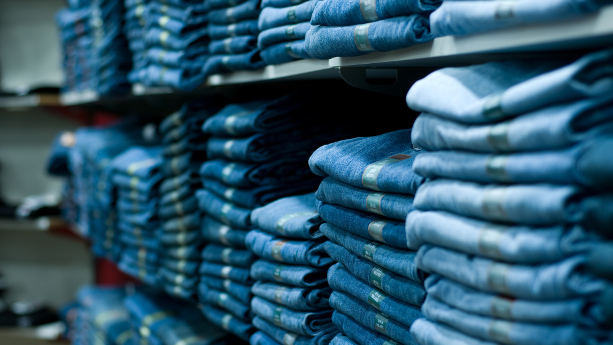Content Overview

FREE CONSULTATION CALL (US, EU & UK)
- Request a free 30-minute call with Ivan Malloci to learn how we can help you with:
- Find product requirements
- Certification and labeling
- Lab testing
Textile Labelling and Fibre Composition Regulation
According to the Textile Labelling and Fibre Composition Regulation, products have to be labelled with information concerning their fibre composition (e.g. 100% Polyester).
Here, we list some examples of common fibres:
- Silk
- Wool
- Nylon
- Polyester
- Cotton
Additionally, non-textile parts of animal origin must be specified, such as fur or leather.
How do I know if my product is classified as a textile product?
According to the regulation, products containing at least 80% by weight of textile fibres are covered. This includes raw, semi-worked, worked, semi-manufactured, and manufactured products. Notice that this is not limited to clothing textiles.
Placement
In general, textile products must carry a durable, legible, easily visible, and accessible label, either on the product or on its packaging. For instance, it is recommended to affix the label on the inner side of a t-shirt, towards the neck.

Sizes and care instructions
Even though the regulation does not require the provision of product size, its inclusion in clothing and certain textile labels aids consumers in choosing products of the appropriate size.
Similar to size labelling, the regulation also does not mandate the provision of care instructions, but including said instructions would help consumers know how to care for their products.
In general, without information concerning size and care instructions, it is possible that neither consumers nor distributors would buy the product. Thus, it is recommended to add such information. It would also increase the risk of returns, in case a piece of clothing is washing in the wrong temperature.
Note that there exist voluntary standards:
- EN 13402, which covers the size designation of clothes; and
- ISO 3758, which covers textile care labelling

REACH
REACH regulates harmful chemical substances in consumer products, including clothing and textiles. Hundreds of chemicals are used during the process of textile manufacturing, including substances that are deemed toxic and, as such, restricted.
For example, phthalates, which are restricted by REACH, might be used to improve the brightness of plastic components. Therefore, it is essential to ensure that your products don’t contain substances above the prescribed limitations under REACH.
Does REACH apply to textiles?
Yes, REACH applies to consumer products in the European Union, including clothing and textile products. Note that some restricted substances are more likely to be found in textiles, such as the one that we list below.
What are the main obligations of REACH regulation?
Companies need to ensure that their products comply with:
a. Substance restrictions as listed in Annex XVII
b. Notification obligations regarding substances listed on the SVHC Candidate List.
How do I know which chemicals and heavy metals are restricted for textiles?
As already mentioned, Annex XVII and the SVHC Candidate List provide a list of restricted substances.
For example, Annex XVII bans the use of Tris (2,3 dibromopropyl) phosphate in textiles such as undergarments and restricts the use of azo colourants and azodyes in textile articles to a maximum of 30 mg/kg (0.003% by weight).
In theory, you could take the time to read through these lists and make sure that your products do not contain any substances exceeding the maximum allowed limit.
However, this is not practical. In many cases, it could be difficult even to know what chemical substances your products contain. A lab testing company can help assess which chemicals, heavy metals, and pollutants to test for and perform the relevant tests.
Hence, if you work with a lab, you don’t need to keep track of all substances that might be restricted.
What restricted substances can be found in clothing and textile products?
These are examples of restricted substances that are found in clothing and textile products:
a. Aromatic amines (from azo dyes, used to provide vibrant colours to textiles)
b. Formaldehyde (used to increase colourfastness and anti-wrinkle of the textiles)
c. Phthalates (might be found in plastic parts of the clothing or textiles)
d. Pentachloroethane (used to clean fabrics)

General Product Safety Regulation (GPSR)
The General Product Safety Regulation covers consumer products and mandates that “only” safe products can be placed on the EU market. Products that are not safe, and thus might pose certain dangers.
Risk examples
- Contain flammable materials
- Present strangulation threats
- Have small parts that come loose easily
General requirements
Below is a general summary of the GPSR requirements:
a. Compliance with safety requirements – for example, requirements set by relevant harmonised standards
b. Documentation (e.g. technical documentation, instructions, test reports)
c. Labelling (e.g. traceability labelling, warnings, instructions)
Product examples
Here are several examples of clothing and products that contain textiles that are covered by standards harmonised under the GPSR:
- Children’s clothing
- Soft baby carriers
- Framed-back baby carriers
- Gymnastic trampolines
Harmonised standards
When a product complies with harmonised standards, there is a presumption of conformity with the safety requirements set by the GPSR.
According to our knowledge, there are only a few harmonised standards that are relevant to textile products. Here are some examples:
a. EN 14682 – Safety of children’s clothing – Cords and drawstrings on children’s clothing – Specifications.
b. EN 13209-1 – Child use and care articles – Baby carriers – Safety requirements and test methods – Part 1: Framed back carriers
c. EN 13209-2 – Child use and care articles – Baby carriers – Safety requirements and test methods – Part 2: Soft carrier
Other standards
Sometimes harmonised standards for a certain product may not exist. In this case, you can still use relevant national, international, or non-harmonised EN standards to assess the safety of your products. Below we list various EN standards by product category
Children’s clothing EN standards
a. EN 17394 Safety of children’s clothing – Security of attachment of buttons – Test method
b. EN 14878 Textiles – Burning behavior of children’s nightwear – Specification
c. EN 17394-1 – Textiles and Textile Products: Part 1 – Safety of children’s clothing – Security of attachment of attached components to infants’ clothing – Specification
d. EN 17394-2 – Textiles and Textile Products: Part 2 – Safety of children’s clothing – Security of attachment of buttons – Test method
e. EN 17394-3 – Textiles and Textile Products: Part 3: Safety of children’s clothing – Security of attachment of metal mechanically applied press fasteners – Test method
f. EN 17394-4 – Textiles and Textile Products: Part 4: Safety of children’s clothing – Security of attachment of components except buttons and metal mechanically applied press fasteners – Test method
Textiles EN standards
a. EN ISO 12952-1 – Textiles. Assessment of the ignitability of bedding items. Ignition source. Smoldering cigarette
b. EN ISO 12952-2 – Textiles. Assessment of the ignitability of bedding items. Part 2: Ignition source: match-flame equivalent
c. EN 13772 – Textiles and textile products. Burning behavior. Curtains and drapes. Measurement of the flame spread of vertically oriented specimens with large ignition source
d. EN 14465 – Textiles – Upholstery fabrics – Specification and methods of test
Personal Protective Equipment (PPE) Regulation
The Personal Protective Equipment (PPE) Regulation sets requirements for PPE, which includes protective clothing and other protective textile products.
Product examples
Here, we provide a few examples of clothing and textile-related protective equipment listed by the PPE Regulation Guidelines:
- Protective diving suits
- Protective clothes for waterskiing
- Two-piece thermal protective garments
- Anti-tick garments
- Beekeeper veils and garments
Risk categories
The PPE Regulation classifies PPE into three distinct categories according to the severity of the risk the PPE is designed to protect from.
Category I
Category I PPE protects against minimal risks such as:
- Superficial mechanical injury
- Contact with weak cleaning materials
- Contact with hot surfaces
Here are a few examples of Category I clothing and textile-related PPE:
- Gloves that protect against natural UV radiation
- Patches that protect the skin against friction
Category II
Category II PPE covers risks that are not listed in Categories I and III. We list below a few examples of clothing and textile-related Category II PPE:
- Diving suits that provide thermal protection
- Protective clothes for waterskiing
- Beekeeper veils and garments
Category III
Category III PPE protects against many types of consequential risks that result in death or irreversible negative health damage, such as:
- Harmful biological agents
- Drowning
- Hazardous substances and mixtures
Here are a few examples of Category III PPE that are relevant for clothing and textiles:
- Harnesses that protect against falling from heights
- Life jackets
Harmonised standards
Here we list some EN standards harmonised under the PPE Regulation that are relevant for clothing and textile products:
a. EN ISO 20471 – High visibility clothing – Test methods and requirements
b. EN 1150 – Protective clothing –visibility clothing for non-professional use – test methods and requirements
c. EN 342 – Protective clothing – Ensembles and garments for protection against cold
d. EN 343 – Protective clothing – Protection against rain
e. EN 1082-1 – Protective clothing – Gloves and arm guards protecting against cuts and stabs by hand knives – Part 1: Chain mail gloves and arm guards
f. EN 13034: Protective clothing against liquid chemicals – Performance requirements for chemical protective clothing offering limited protective performance against liquid chemicals
Requirements
Here we list the main requirements of the PPE Regulation:
a. Technical documentation
b. Declaration of Conformity
c. Test reports
d. Instructions
e. CE marking
f. Traceability information (e.g., type, batch, serial number, name, registered trademark or trade name, postal address)
g. Additional markings (if needed)
Note that Category II and III PPE undergoing a conformity assessment procedure necessitate the involvement of a Notified Body.
Biocidal Products Regulation
The Biocidal Products Regulation covers clothing and textiles treated with biocides. According to Annex V of the regulation, biocides can be found in textiles treated with:
a. Disinfectants and algaecides
b. Preservatives used in fibre, leather, rubber and polymerised materials
Product examples
While the regulation does not mention examples of biocide-treated products, the Swedish Chemicals Agency lists several textile and clothing-related products that may be treated with biocides, such as:
- Cushions
- Sportswear
- Cleaning cloths
- Mattresses
Substance restrictions
ECHA permits the use of several biocides in textiles and includes them on its Union List of approved active substances. This includes biocides such as:
- 2-Biphenyl-2-ol
- Fludioxonil
- Hydrogen peroxide
- Chlorocresol
Claims
According to the regulation, an article for which a claim is made regarding its biocidal properties should include the labelling information listed in Article 58.
Requirements
The regulation requires importers and manufacturers of clothing and textiles treated with biocides – or for which a biocidal claim is made – to:
a. Comply with relevant substance restrictions
b. Provide a label that consists of:
- A statement that the treated product contains biocidal products
- The attributed biocidal property
- Names of all active substances in the biocidal product
- Names of all nanomaterials in the biocidal product
- Instructions for use and precautions to be taken
c. Provide for free, within 45 days, information regarding the product’s biocidal treatment, when requested by the consumer.

















kindly provide the clothing regulatory for Switzerland
What are the EU mandatory requirements for a printed polyester scarf?
We sell outdoor clothing mainly in the UK however we do online sales direct to customers in Europe. For Germany in particular , by law do our labels and swing tags have to be in the German language or will the original labels in English be fine.
Hi is it mandatory for all adult apparel(not sleepwear) sold in EU to have REACH testing done?
Helloo,
Does EU requires the name of distribitor or manufacture on textiles as hats and jackets?
Do you also have more information of the information needed on accessories as signs?
Appreciate your help!
Hi Fredric, do you know if fabric composition is required on the products like tie, bowman and bath mat?
Hi N,
I cannot remember. But, there is a list on the EU website.
Yes its required on all product, where the product is too small to have the COO like socks and bow ties, this then needs to be added to the packaging.
Hi
I would like to inquire about what recent regulations the company need to comply for exporting garments manufacturing in India to the EU.
I am presently based in Scotland and in a process of registering an office.
Kindly advise,
Best regards,
Walty
Hi Walty,
I suggest you try our compliance information tool: https://www.compliancegate.com
Are European clothing sellers required to indicate fabric contents at POS for the clothing articles they sell?
Hi Robert,
What do you mean with POS? The products must be correctly labeled and the fiber content is part of that requirement.
Hi Fredrik
I am a new learner of textile compliance because I want to make my career in this field. So please suggest me how I can pursue in future
Hi Raja,
I guess the best way forward is to seek employment as some of the big testing companies like SGS or Intertek
POS= Point of sale. If sold online that would mean on the website at the point of looking at the item and determine to buy. In physical store Point of sale could either be in the store on a sign next to the product or on the product itself.
For textile for EU it have to be both on the product (sew-in label) in national language, and if sold online it has to be on the product page in the webshop as well in national language, as it has to be accessible at point of sale. :) Article 16 in EC 1007/2011.
Hi Fredrik,
Great article.
Do you have any information on what tests need to be done for children’s footwear?
what is the legal fabric composition tolerance for EU? eg. the fabric in 100% Cotton, 75%Cotton/23%Polyamide/2%Elastane
it is 0 on single component like 100% cotton ( no tolerance)
+-3% on multi component.
That’s interesting that there are no regulations on sizes or care instructions being labeled on textiles in the EU. I feel like there would be different regulations for that kind of thing in different parts of the world. I’ll have to consider getting someone to help me make sure that I follow all the rules of different countries if I decide to start a company and it does well enough to expand into different countries.
Perhaps, but it would also be very problematic to regulate the exact measurements as different types of apparel have different fits. It’s probably best if the governments stay out of that.
internationally there is no law in regards to size and care instruction . But suggested care must protect the products in its life . Size always depends on customer size requirement and fit comments .